On every mission during the Global Reef Expedition survey divers can usually point to one dive as being the highlight of the trip. It might be a dive with lots of great looking healthy coral or maybe a dive where a new species of fish or other creature like a nudibranch or giant clam was seen. Possibly it was a dive with clear water and bright sunlight where seemingly unlimited visibility allowed the entire reefscape to be viewed on the dive. The reasons behind the “Best Dive” designation are varied and personal in many cases but for a dive that our group had a few days back I think it soundly registered at or near the top of the candidates for Best Dive of the entire trip.
Here’s what made this the Best Dive of the trip for me (and will be hard to top in the remaining days of this mission). First, we had been diving mid-shelf reefs for several days. These reef systems are a bit more sheltered and have lacked the good visibility of some of our dives on the forereef areas which face open water. We could see from the surface that the water was much clearer than we’d encountered recently as we could actually see down to the reef below. Some of our dives have been in quite murky conditions—science often happens in places where recreational divers would never bother to dive.
We were all cheerful about the prospect of a nice visibility dive but were totally unprepared for the melee that we backrolled into. As we descended we were engulfed in a swirling tornado of fishes. Large schools of many pelagic species took note of our entry to their watery realm and came over to check us out. In addition to a few small Gray Reef Sharks keeping their distance, we were wrapped in a circling school of Blackfin Barracudas (Sphyraena qenie) mixed with two species of jacks—Bigeye Trevally (Caranx sexfasciatus) and Rainbow Runners (Elagatis bipinnulatus)—and a few Red Snappers (Lutjanus bohar) thrown in for good measure. The bulk of this cloud of fishes is made up of Sleek Unicornfish (Naso hexacanthus) which formed the largest school of these I’ve seen to date.
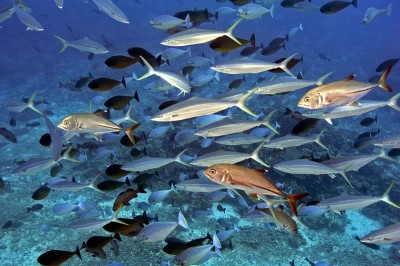
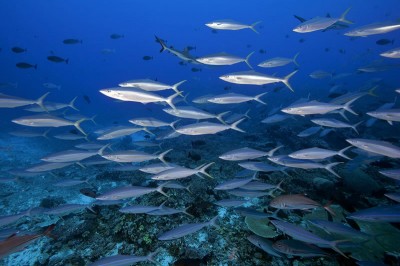
The swirling mixed mass of fishes that came to greet us (left).
Though the Gray Reef Sharks kept their distance, the Rainbow Runners came in close and circled us (right).
(Click-thru on images for greater detail.)
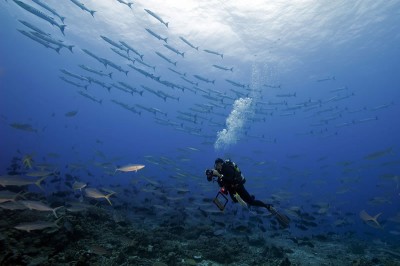
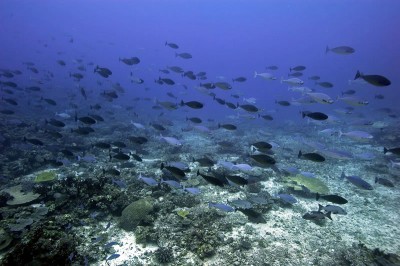
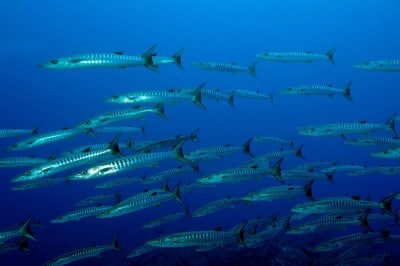
My dive buddy Anderson Mayfield looks on in amazement at the wall of fish and tries to capture the moment with photos (left).
Light and dark color phases of the Sleek Unicornfish head over the reef in a polarized school many hundred strong (middle).
School of Blackfin Barracudas come in close and form a closed circular school around us (right).
(Click-thru on images for greater detail.)
As we left the swirling fish action in the shallows and traveled down toward 20 meters depth to begin our work, we spotted a long ridge of coral separated from the shallower reef by a sandy area. The top of this ridge was right at 20 meters and so was a great place to start my coral photo transects. The ridge was covered in great mounding corals, acroporids forming large tables as well as vast thickets of the branching species, and sizeable colonies of the coral Pocillopora eydouxi which we have seen in other countries during the Global Reef Expedition but so far has been quite rare during our survey of the Great Barrier Reef.
We followed this ridge for some time as it varied in composition from dense thickets of acroporids to areas dominated more by larger individual corals. For a good portion of the time the live coral cover was from 80-100% indicating a healthy reef that had not seen too many recent disturbances. Hiding in a patch of a yellow species of Acropora there was a high density of the striking Two-spot Snapper (Lutjanus biguttatus) which I had only seen before as individuals or small groups. For me this dive had it all—a great assortment and incredible density of fishes, scenic vistas of live coral cover, and just as importantly, great visibility to be able to enjoy it all.
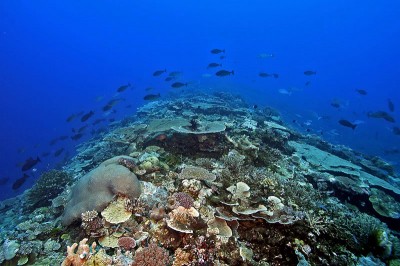

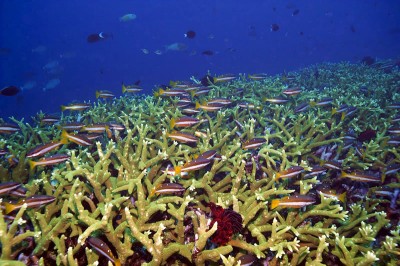
Sleek Unicornfish sail over the top of the coral covered ridge showing large mounding corals and table acroporids (left).
An expansive patch of yellow branching Acropora (middle)
is home to a large population of Two-spot Snappers (right).
(Click-thru on images for greater detail.)
Photos by Ken Marks.